Sam Browne belt
The Sam Browne belt is a wide belt, usually leather, supported by a narrower strap passing diagonally over the right shoulder (although Royal Canadian Mounted Police non-commissioned members wear theirs over the left shoulder).[1] It is most often a part of a military or police uniform.[2]
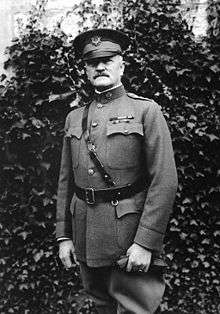
Origins
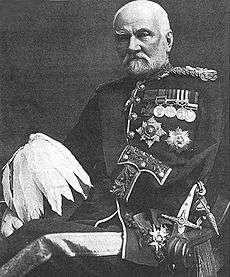
_(2).jpg)
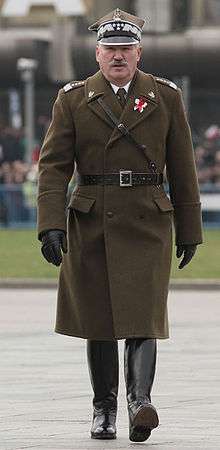
General Sir Sam Browne was a 19th-century British Indian Army officer who had lost his left arm to a sword cut during the Sepoy Rebellion;[3] this made it difficult for him to draw his sword, because the left hand was typically used to steady the scabbard while the right drew out the sword.[4]
Browne came up with the idea of wearing a second belt which went over his right shoulder to hold the scabbard steady. This would hook into a waist belt with D-rings for attaching accessories. It also securely carried a pistol in a flap-holster on his right hip and included a binocular case with a neck-strap. Other officers began wearing a similar rig and eventually it became part of the standard uniform. During the Boer War, it was copied by other troops and eventually became standard issue.[5]
Infantry officers wore a variant that used two suspender-like straps instead of the cross-belt. It was supposedly invented in 1878 by Lieutenant Basil Templer Graham-Montgomery, of the 60th Rifles, while serving in India.
Use
Due to its former use as equipment for carrying a sword, it was traditionally only worn by those to whom a sword would historically have been issued, namely commissioned officers and warrant officers.
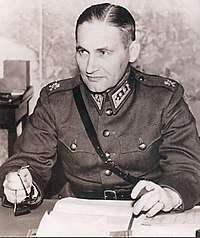
Finland
In the Finnish Army (as well as in Finnish Air Force) the Sam Browne belt, officially known as a "command belt" or "officer belt", has been used by officers and senior NCOs as well as officer cadets when wearing service, dress or parade uniforms. Currently it is mainly used by high-ranking officers during parades and other ceremonies, as it is only worn with dress uniform M58 and service uniform M83; while most Army and Air Force personnel, excluding cadets studying in the National Defence College as well as soldiers on ceremonial duties, use the camouflage uniform M05 as their service uniform, and the use of the "command belt" with any camouflage uniform except M62 (already phased out of service) is strictly forbidden.
Germany

The Sam Browne belt featured prominently in many uniforms used by the Nazi Party in Nazi Germany, again in imitation of earlier European uniforms. It was popular with Adolf Hitler[6] and other leading Nazi officials.[7][8][9]
Ireland
The Irish Citizen Army, Irish Volunteers and Irish Republican Army (IRA) made extensive use of Sam Browne belts during the Irish revolutionary period (1916–23).[10][11] This included women serving with the Irish Citizen Army, among them Constance Markievicz.[12] The folk song "The Broad Black Brimmer" also mentions the Sam Browne belt.[13] They later were used by the Garda Síochána and the National Army.[14]
United Kingdom and the Commonwealth
In the 20th century it was a mainstay in the British Army officers' corps, being adopted service-wide in 1900 during the Second Boer War after limited use in India, and later becoming popular with military forces throughout the Commonwealth.[15]
After World War II the Sam Browne belt saw a decline in use in the Commonwealth. It was dropped from the standard officer's uniform in 1943[16] and replaced by the cloth P37 and P44 web gear. However, officers and warrant officers class 1 of the British Army and Royal Marines still wear it in service (No.2) dress and in non-ceremonial versions of No.1 dress.[17]
It was phased out by the Canadian military beginning with the unification of the armed services in 1968.[18]
In Australia, all officers and warrant officers class 1 are entitled to wear the belt in ceremonial dress.[19] Within the corps of the Australian Army there is some variation, with members of the Royal Australian Armoured Corps, Royal Australian Army Nursing Corps and Australian Army Aviation Corps wearing black Sam Browne belts.[20]
Rifle belt
.jpg)
A different arrangement, supposedly invented in 1878 by Basil Templer Graham-Montgomery of the 60th Rifles while serving in India, consists of a similar wide belt with two vertical supporting straps, one over each shoulder. This design puts the burden of the gear, with its heavy ammo pouches on the belt and straps, on both shoulders.
It was worn by the officers of British and Commonwealth rifle regiments, who had to carry a rifle as their service arm rather than a pistol. It was also worn by big game hunters in Africa and India in the late 19th and mid-20th centuries. It is often seen worn in movies or TV shows as part of the costume of explorers or big game hunters.
United States
During World War I, the Sam Browne Belt was approved by General Pershing, commander of the AEF, for wear by American officers as a rank distinction. However, the Army as a whole did not immediately approve its use.[1][21] MPs were positioned at stateside docks and confiscated them from returning officers.[22] The United States Army mandated the Sam Browne belt for overseas soldiers in 1918 under the name "Liberty belt"[23] and for all service members in 1921, this time under the internationally accepted name "Sam Browne belt".[24][25] It was a standard part of the uniform between World War I and World War II. It was limited in use in 1940 when the Army abandoned sabers[26] and replaced with a cloth waistbelt that was sewn to the officer's jacket.[22]
During World War I the Marine Corps adopted a brown leather Sam Browne Belt. It was later changed to black, the official color of Navy and Marine Corps leather gear. It is worn as part of the dress Blue A & B, Blue-white dress, and service A uniform by sword-bearing commissioned and warrant officers.
After the First World War, Sam Browne belts "become almost universal among American police".[27] The utility belts worn today by American police usually lack the cross-strap and the attachments for them. The belt fastens in the same way, with the bar of the buckle engaging a pair of hooks and the end of the belt retained by a post and keeper loop. They are also frequently fully lined, as opposed to the old style half-linings, to support equipment the length of the belt.[27]
Use in police forces worldwide
The Sam Browne belt is largely obsolete in police and security use due to risk of strangulation by potential opponents. It has sometimes been referred to as a Suicide Belt by personnel.[28] It had enjoyed some popularity with civilian police agencies worldwide and was probably most widely worn in this context during the 1940s and 1950s. This use has gradually faded out due to field safety concerns. It is part of the ceremonial dress uniform of many agencies, most notably the Red Serge worn by the Royal Canadian Mounted Police.[29] The RCMP enlisted ranks wear the cross belt over the left shoulder to support the pistol worn on the right side. Enlisted members who are left handed wear the cross strap over the right shoulder to support the pistol worn on the left side. RCMP commissioned officers wear the cross strap over the right shoulder due to the need to support a sword when wearing the red serge ceremonial uniform. This difference of wearing the cross strap over different shoulders for commissioned and non-commissioned members is even maintained when wearing the stripped Sam Browne belt (no pistol or sword). [30]
Safety
The Sam Browne belt has been proposed as a solution to occupational safety and health concerns about injury due to the weight of equipment on police officers' belts.[31] However, others have expressed concern that the vertical design of the belt could enable criminals to gain physical control of law enforcement officers in an altercation.[32][33]
Civilian use
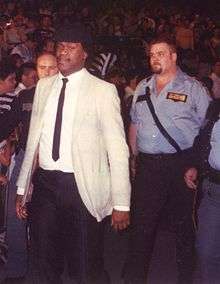
During the interwar period, the belt became fashionable among some American[34] and European[35] women. Eleanor Roosevelt, the first lady of the United States at the time, openly spoke out against the practice.[36] The belts also became a symbol of civilian authority by "everybody from bus drivers to volunteer schoolboy traffic cops".[37] The belt's use by junior safety patrol members is archetypal.[38][39]
Since the 1970s, the use of Sam Browne Belts has increased in popularity within the Queer BDSM Leather subculture.[40]
Reflective Sam Browne belts are a popular safety device among cyclists for increasing their visibility, and a bright orange version is often worn by school crossing guards in junior safety patrols.[41]
References
- "'Sam Browne' Belts Are Barred Here" (PDF). New York Times. 18 October 1917. Retrieved 28 January 2013.
These belts have been worn by a number of British army officers and consist of a broad waist belt of leather, connected with a narrower leather strap that goes over the shoulder. The 'Sam Browne' belts serve no useful purpose but set off the uniform of an officer.
- "Sam Browne belt". Merriam-Webster Dictionary. Merriam-Webster. Retrieved 28 January 2013.
- "Sam browne belts originally devised for one-armed men". The Atlanta Constitution. 23 July 1921.
- Craig, Berry. "A Famous Military Fashion and the Man Behind It". O&P Business News : Linking the Orthotic and Prosthetic Profession. 20 (8): 62–63.
- Lee Lofland (8 August 2007). Howdunit Book of Police Procedure and Investigation: A Guide for Writers. Writer's Digest Books. p. 62. ISBN 978-1-58297-455-2. Retrieved 28 January 2013.
- Samuel Thurston Williamson (9 November 1941). "Sam Browne. His Belt: There Was A British Officer Named Sam Browne And He Invented The Belt Which Today Even Adolf Hitler Wears". New York Times: SM8. Retrieved 28 January 2013.
General Sam Browne must look down in wonder at the host of uniform-wearers who sport his belt today. ...
- Roger A. Beaumont (2000). The Nazis' March to Chaos: The Hitler Era Through the Lenses of Chaos-Complexity Theory. Greenwood Publishing Group. p. 133. ISBN 978-0-275-96708-6. Retrieved 28 January 2013.
- Ronald C. Newton (1992). The "Nazi Menace" in Argentina, 1931-1947. Stanford University Press. p. 186. ISBN 978-0-8047-1929-2. Retrieved 28 January 2013.
- David Miller (30 December 2007). Fighting Men of World War II: Uniforms, Equipment and Weapons. Stackpole Books. p. 46. ISBN 978-0-8117-0277-5. Retrieved 28 January 2013.
- Oppenheimer, A. R. (16 October 2008). IRA, The Bombs and the Bullets: A History of Deadly Ingenuity. Irish Academic Press. ISBN 9781788550185 – via Google Books.
- "1922: Bandolier and Sam Browne belt at Whyte's Auctions - Whyte's - Irish Art & Collectibles". Whyte's.
- admin (18 February 2011). "Irish Citizen Army Uniforms and Equipment 1916". The Irish War.
- "The Wolfe Tones – The Broad Black Brimmer" – via genius.com.
- "Garda too strong, yet too weak". Village Magazine. 4 April 2017.
- Charles John Ffoulkes; Edward Campbell Hopkinson (1967). Sword, Lance & Bayonet: A Record of the Arms of the British Army & Navy. CUP Archive. p. 94. GGKEY:AQU0Q8J935F. Retrieved 28 January 2013.
- "Sam Browne' Is Casualty. British Drop Belt Equipment From Officers' Uniform". New York Times. September 3, 1943. Retrieved 2014-01-03.
- Paragraph 20, Dress Regulations for the Mercian Regiment, January 2009
- Lieutenant C.M. Stevens, Seaforth Highlanders of Canada
- "The Same Browne belt-Australian Army". Australian Army. Retrieved 2012-05-25.
- Jobson, Chris (2009). Looking Forward, Looking Back: Customs and Traditions of the Australian Army. Wavell Heights, Queensland: Big Sky Publishing. p. 28. ISBN 978-0-9803251-6-4.
- "Officers Quick to Don Sam Browne Belts. Pershing's Order Abrogating Old Regulation Is Welcomed at Camp Edwards" (PDF). New York Times. July 15, 1921. Retrieved 2014-01-03.
- Jerold E. Brown (2001). Historical Dictionary of the U.S. Army. Greenwood Publishing Group. p. 410. ISBN 978-0-313-29322-1. Retrieved 28 January 2013.
- ""Sam Browne" Belt Adopted by U.S. Army And Named "Liberty"". The Washington Post. 4 Jan 1918.
- "Sam Browne Belt Made Regulation Equipment in Army". The Washington Post. 7 July 1921.
- "All U.S. Officers Ordered To Wear Sam Browne Belts". Chicago Daily Tribune. 7 July 1921.
- "Army Abandons Sabers And Limits Sam Brownes". New York Times. November 13, 1940. Retrieved 2014-01-03.
The Sam Browne belt, too, seems to be on the decline. In the last war it was worn by officers of British, French and American armies. The British restricted its use ...
- Massad Ayoob (28 February 2011). The Gun Digest Book of Combat Handgunnery. Gun Digest Books. p. 117. ISBN 978-1-4402-2654-0. Retrieved 28 January 2013.
- Howser, Huell (Host, Writer) (October 2009). Visiting...With Huell Howser [LAPD Motors] (DVD). Los Angeles, CA: Huell Howser Productions.
- David Ross (24 March 1988). The Royal Canadian Mounted Police 1873-1987. Osprey Publishing. p. 36. ISBN 978-0-85045-834-3. Retrieved 28 January 2013.
- News; Canada (24 August 2016). "Mounties update uniform to allow navy blue hijabs in bid to attract Muslim women to the force - National Post".
- Soldo, Sandra (February 2004). "Overloaded: How the New South Wales police accoutrement belt plagues its wearers". Police Journal Online. 85 (1).
- US patent 2564564
- US patent 3352467
- "Women Like Sam Browne Belts". New York Times. 21 October 1917.
- "Sam Browne Belt Worn in France by Women Hikers". Chicago Daily Tribune. 4 October 1936.
- Kathleen McLaughlin (27 July 1941). "'No Sam Browne Belts,' Says Mrs. Roosevelt". New York Times. Retrieved 28 January 2013.
Mrs. Franklin D. Roosevelt confesses to only one foreboding about American women now mobilizing for defense activities. She is fearful of the spread of a Sam Browne belt complex and the flimflam it symbolizes. ...
- "Nature Ramblings: Admirals Wearing Spurs". The Science News-Letter. Society for Science & the Public. 27 (729). 30 March 1935.
- Bill Lohmann Times-Dispatch, Staff Writer. "Aaa Safety Patrols * 1920-1995 75 Years of Safety Now as then, Kids in the Sam Browne Belts Stand between their Schoolmates and Danger." Richmond Times - Dispatch, Sep 20, 1995.
- "Helping to Keep Schools Safe." Times - News, Aug 14, 2009.
- Geczy, Adam; Karaminas, Vicki (2013). Queer Style. Bloomsbury Academic. ISBN 978-1-8478-8736-8. Retrieved 27 October 2015.
- Pier Battistelli (22 November 2011). Italian Army Elite Units & Special Forces 1940-43. Osprey Publishing. p. 49. ISBN 978-1-84908-895-4. Retrieved 28 January 2013.